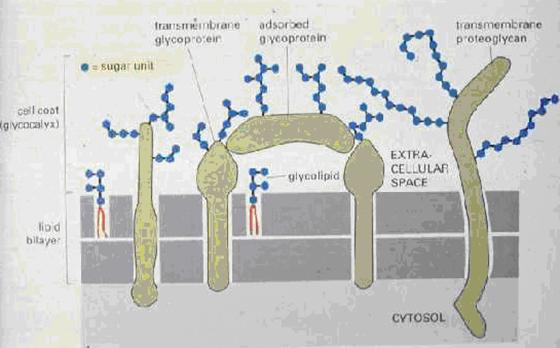All seeds contain lectins in their seed coats and cotlyledons (part that becomes the first leaves in some plants). Highest concentrations are found in grains and legumes (includes peanuts, soybeans and beans), and also found in abundance in nuts, seeds (other than grains), members of the nightshade family of plants (including tomatoes, peppers, eggplants and potatoes), and seafood. About 30% of fresh foods contain lectins in varying amounts.
Which foods have the highest concentrations of harmful lectins?
Lectins are carbohydrate-binding proteins that attach to cell membranes. E.g. Glycoproteins (protein + sugar molecules) are found on the outside of the cell membrane, with the sugar (oligosaccharides - the strings of blue circles in the diagram) facing out, making it accessible for lectins to latch onto.

Oligosaccharide side chains attached to membrane glycolipids and glycoproteins
Lectins have essential functions in all life forms
- In our bodies. Lectins allow cell-to-cell adherence, inflammation control and programmed cell death; many types of cell receptors are lectins;
- Part of plants' natural defense mechanisms. Important for seed survival, lectins discourage pests from eating them e.g. insects, bacteria, fungi, man??? :) Their intent is generally to repel (not kill) predators by stimulating a negative reaction, although some lectins have proven fatal to various microorganisms.
Prolamins and agglutinins are currently the only two classes of lectins widely recognized as antinutrients in food. However, it is important to note that the presence of these harmful lectins can be significantly reduced with appropriate food preparation. Lectins have the ability to bind to virtually all cell types, but when they bind to glycoproteins on the epithelial surface of the small intestine, they can elicit both local and/or systemic reactions involving:
• Damage /inflammation
• Breach of the gut lining
• Immune system modulation
• Dysbiosis (an imbalance in gut flora)
• Nutrient malabsorption;
Prolamins and agglutinins can cause some serious health problems in those genetically susceptible to their effects. E.g. WHOLE wheat contains the prolamin gliadin and several agglutinins, including wheat germ agglutinin (WGA) (0.5g / kg). Gliadin is one of the more infamous lectins - being the digestive-troubling half of the gluten molecule that affects those with gluten-sensitivity. WGA and other food agglutinins, affect us all to some degree, but in those more prone to its effects, it can wreak havoc in their gut and body tissues, leaving a wake of inflammatory devastation that results in any of a long list of common health problems, including rheumatoid arthritis, chronic candida, allergies, diabetes . . . and many others.
Health Effects of Lectins (Being Updated)
We are eating far more whole grains than we used to eat. Before the agricultural revolution with the introduction of big-farming methods, grains were a small part of our diet, now they are readily available to us in quantity with a quick trip to the grocery store --- think bread, crackers, pasta, rice and cereals. Yes of course, whole grains are certainly more nutritious than refined grains, but eating too many whole grains also introduces an abundance of harmful antinutrients, such as lectins and phytic acid.
Traditional food preparation methods can remove some lectins. To wit: soaking, sprouting, fermenting and cooking. However, agglutinins tend to resist degradation.